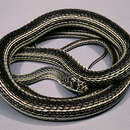en
names in breadcrumbs


Older texts will show Schott's whipsnake and Ruthven's whipsnake as races of this species; they are now considered full species.
Fairly common in parts of its range, especially near water.
US Federal List: no special status
CITES: no special status
IUCN Red List of Threatened Species: least concern
This is an aesthetically interesting snake that probably helps to control rodent numbers in rangeland.
The striped whipsnake eats amphibians, smaller snakes, and lizards. Three other important prey to the whipsnake are bird nestlings, bird eggs, and rodents. This snake is an active hunter that finds its food by vision and scent trailing, although vision plays the larger role out of the two. Juvenile whipsnakes consume insects, including crickets, locusts, and cicadas. (Bartlett and Tenant 2000).
Masticophis taeniatus is found from central Texas and neighboring Mexico through Arizona and Utah to Nevada, northern California, Oregon, and southern Washington. (Stebbins 1985)
Biogeographic Regions: nearctic (Native )
In the southern part of its range this species is associated with open woodlands in mountainous terrain. In the north it is found in high altitude woodlands, as well as in desert scrub, grassland, and juniper-studded rangelands at the lower altitudes. Striped whipsnakes can often be found near pond and river edges where water is readily available and amphibians can be found. (Bartlett and Tenant 2000).
Terrestrial Biomes: desert or dune ; savanna or grassland ; mountains
This is a slender snake with an adult length of 36 to 72 inches (90-183 cm). Dorsally the snake is typically dark brown to gray or blue, with three light stripes on each side with a color range from grey to white. The side stripe is divided by a broken to continous dark band. The dorsal scales are smooth, in fifteen rows at midbody. The anal plate is divided. (Stebbins 1985; Bartlett and Tenant 2000).
Females lay 3 to 12 bumpy-shelled eggs in the spring or early summer. The eggs take two to three months to hatch, and the slender young are about 14 inches long. (Stebbins 1985; Bartlett and Tenant 2000).